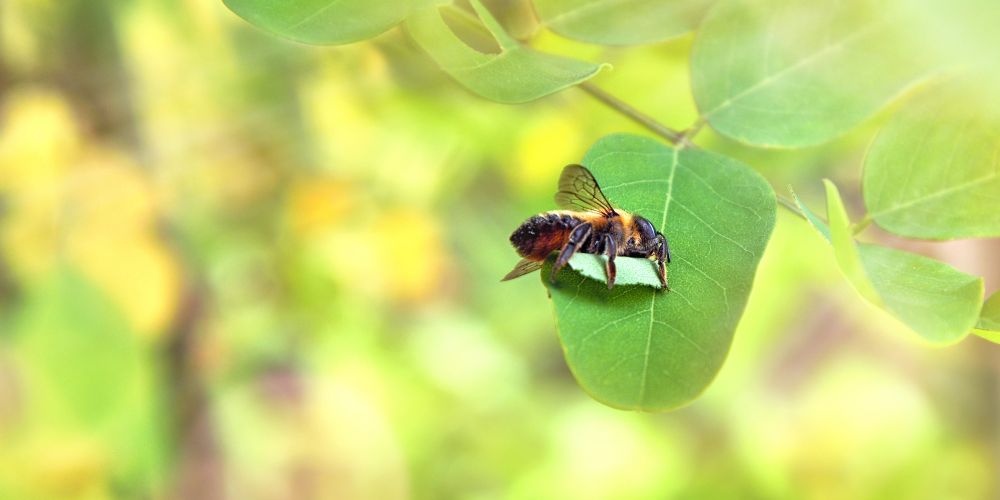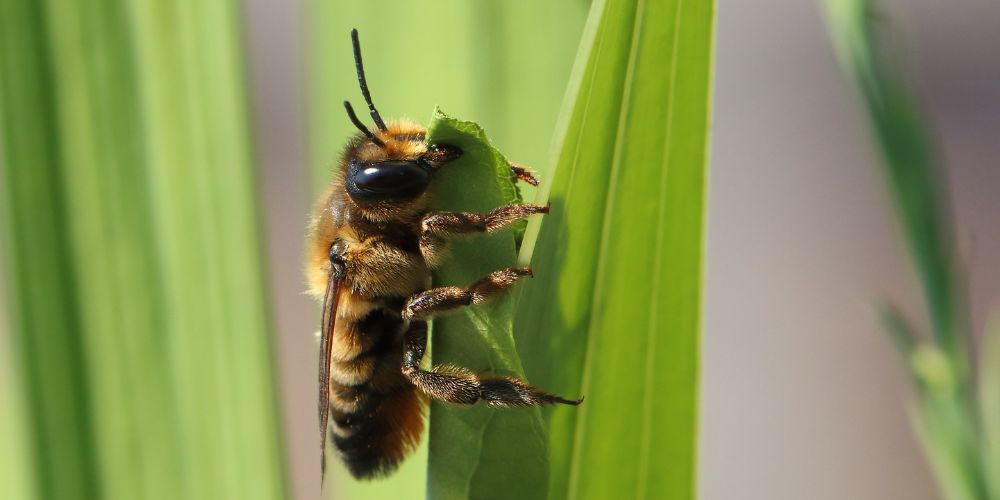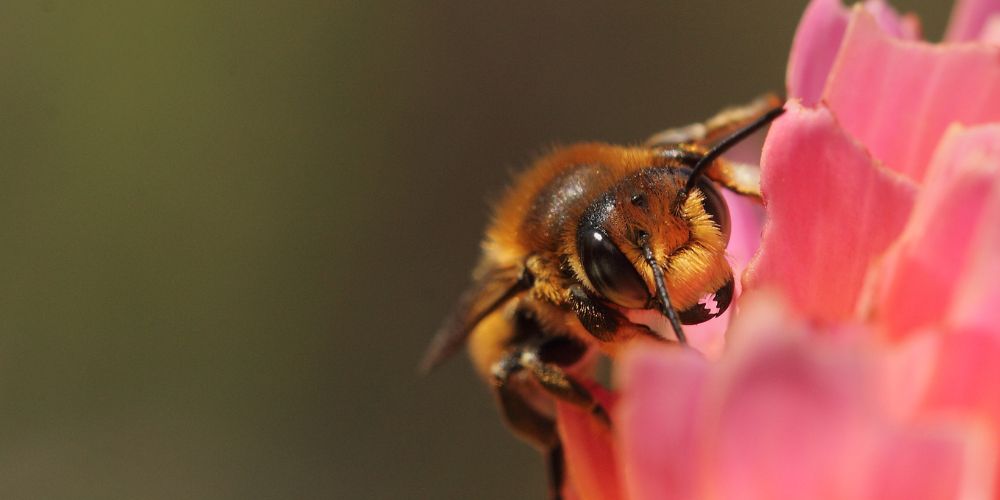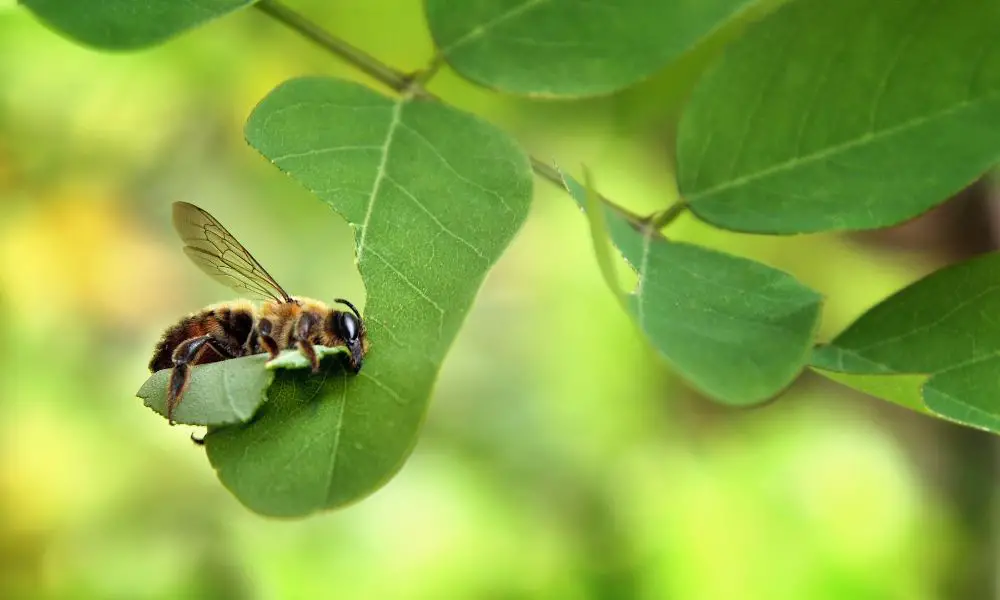Last updated on January 3rd, 2024 at 01:50 pm
The leafcutter bee is a fascinating species of bee belonging to the genus Megachile which also includes resin bees and mason bees.
*This subset belongs to the much larger Megachilidae cosmopolitan family made up of solitary species.
Leafcutter bees have gained their name due to their unique behaviour of leaf cutting. This involves removing circular pieces of leaves and petals from plants to construct nests.
It’s important to note that, unlike many other bee species who chew organic matter for their nests, leafcutter bees actually cut out entire sections of leaf and return them intact to their nest to begin building with.
What do leafcutter bees look like?

Leafcutter bees are very similar to the size of a honeybee. Their bodies are dark in colour but they have one key difference that makes them easily distinguishable from their much more common relatives.
Unlike honeybees that store and carry pollen on their hind legs, leafcutting bees are equipped with a set of hairs (scopa) that line the underside of their abdomen, allowing them to collect pollen as they travel from flower to flower.
This often gives leafcutter bees a lightly coloured or orange abdomen caused by the excess build-up of pollen.
You can see them in all their glory in the video of leafcutter bees below:
The Leafcutter Bee Lifecycle
Let’s take a closer look at what happens to a leafcutter bee throughout the year.
Late spring
Mature larvae from last year overwinter, waiting for the temperatures to rise enough to begin an intrinsic change in their biology.
When temperatures rise above 70°F or 21°C the mature larvae will start to metamorphose into a mature adult bee ready to take flight.
The amount of development time this requires depends on how quickly the outside temperatures increase, particularly hot springs will see leafcutters emerge much earlier than they normally would.
Adult bees will now set about building their nests, gathering food and resources and laying eggs for the next generation of leafcutter bees.
Their first task will always be to mate with a bee of the opposite sex. Males of the species will emerge from their nests approximately two days before their female counterparts so you may see large groups of males waiting outside nests for females to emerge.
Summer
After mating in late spring female leafcutter bees’ first task is to find a good spot to start constructing their nest (we’ll cover exactly how they choose their nest site shortly).
Once construction has finished it’s time to set about gathering all the necessary resources to start her brood.
Beginning at the rear of her nesting chamber the bee will begin to create pockets or loaves of pollen and nectar in different compartments of the nest.
A single egg will be placed on top of each of these loaves and the chamber will be sealed with the same trimmed leaf used to construct the rest of the nest. This process is repeated until all the empty tunnels and chambers are full.
Interestingly there does seem to be a diversity of cavities with female eggs placed further towards the back chambers to provide the most protection possible from potential predators and severe weather conditions.
Late summer
Depending on the exterior temperature, eggs will begin to hatch anywhere from 2-15 days after they were capped in their chambers.
At this point, the single larva will gorge itself on the pollen and nectar it’s surrounded by. Once feeding is complete the young larva moves on to the next step in its life cycle.
Each larva will begin to spin a waterproof silk cocoon around itself to help protect them from the harsh realities of overwintering.
During this process, the young bee will position its head to face the entrance of the chamber, ready to emerge in the spring of the following year.
Winter
As winter arrives all development will stop as the bee becomes dormant to conserve the precious energy it gained during the warmer months.
As the sun starts to rise higher in the sky and the warmth of spring begins to reach the bees in their nest, this whole cycle begins again.
How do they cut leaves?

As their name suggests leafcutter bees are adept at cutting leaves to help them build nests for the soon-to-arrive baby bees.
They use powerful mandibles to cut out sections of leaf and foliage before storing them between their legs for their return flight.
Plants that have been visited by leafcutter bees display clear signs of foraging, you’ll see semicircles cut into the leaf starting from the edges.
Check out the image below which shows the handy work of a leafcutter bee.
How do leafcutter bees make their nests?
Before they begin to construct their nest, females will need a suitable cavity to start their leafcutter bee nest.
Leafcutter bees prefer to nest in long chambers or cylinders (this is known as cavity nesting), these locations include:
- Plant stems
- Holes in the ground
- Man-made structures with cylindrical cavities
- Old snail shells
- Hollow twigs
- Drill holes in concrete walls
Once they’ve picked a good site to start constructing their nest they will begin to forage for nearby leaves to create the nest’s internal structure.
Inside the nest
Once the female leafcutter bee finds a suitable nest site she’ll start arranging her segments of leaf to build overlapping tube within the cavity.
Some species of leafcutter bees will replace segments of leaves with petals as their building material of choice.
Each segment of a leaf will become a nest cell ready to harbour a larva that will eventually mature into a new generation of bees.
Initially, the female leafcutter bee will place an egg in each cell with a small deposit of pollen for sustenance as the larva matures.
The male larva is placed at the top of the nest closest to the entrance with the female larva occupying the cells deeper within the nest, after each egg is laid the female will diligently cover it with another segment of a leaf.
These eggs will eventually become larvae in late summer before overwintering within the nest until they emerge the following spring as fully mature leafcutter bees.
Leafcutter bees are spread throughout the entire United Kingdom but with a much higher population in the south of the country due to the warmer summers and milder winters.
Pollination

Leafcutter bees are incredibly effective pollinators, in a study carried out by the US Agricultural Research Service they found that a single Alfalfa leafcutter bee had the same pollination efficacy as up to 20 honeybees.
Some of the most notable crops and flowers pollinated include:
- Alfalfa
- Blueberries
- Buckwheat
- Alfalfa
- Clover
- Roses
- Sunflowers
- Redbud trees
- Peas
- Lamb’s quarters
- Lilac
- It’s important to note that these are just some of the common species and leafcutter bees will visit an incredibly wide variety of forage.
Do leafcutter bees damage plants in your garden?
No, while the jagged cuts in leaves and petals can be a sign of something more malicious the neat circular cuts created by these bees are nothing to worry about.
Unfortunately, many gardeners see these signs and react by spraying pesticides that can have catastrophic consequences for local nests and other nearby wildlife.
Conclusion
While leafcutter bees have very different characteristics from the more common honeybee and bumblebee they are fantastic additions to any garden or wild space.
Despite their behaviour, their impact on plant life is negligible and it would take considerable amounts of leafcutter bees in one location to cause any adverse effect on flora in the area.





